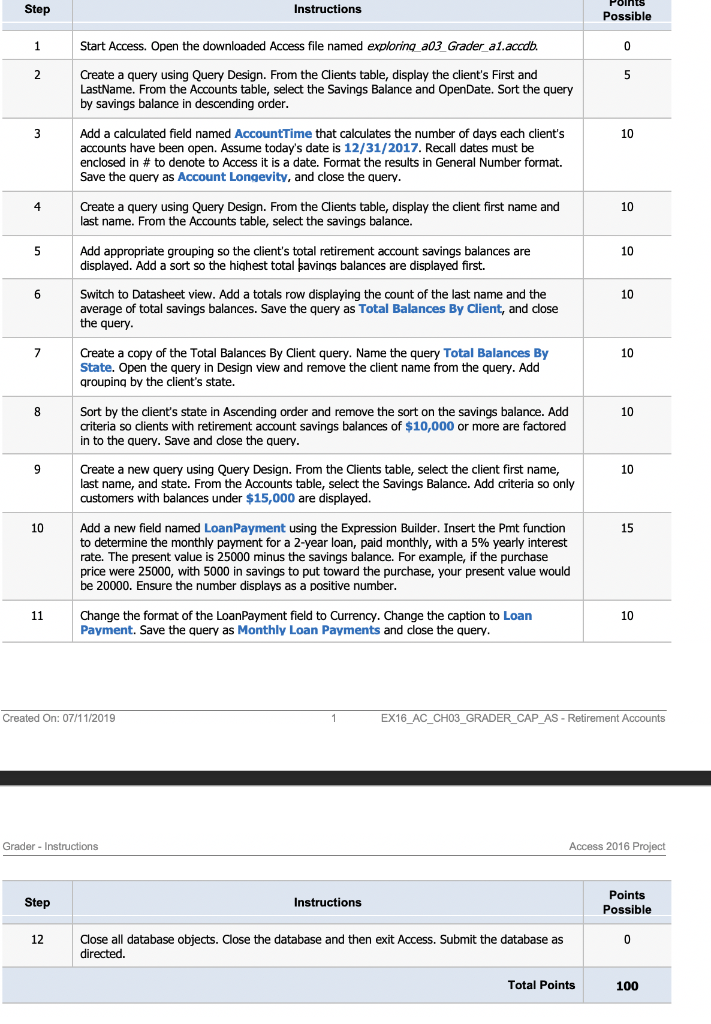Answered step by step
Verified Expert Solution
Question
1 Approved Answer
I keep getting these answers wrong. Please show work! Step Instructions Polnis Possible Start Access. Open the downloaded Access file named exploring a03 Grader al.accdb.
I keep getting these answers wrong. Please show work!

Step Instructions Polnis Possible Start Access. Open the downloaded Access file named exploring a03 Grader al.accdb. Create a query using Query Design. From the Clients table, display the client's First and LastName. From the Accounts table, select the Savings Balance and OpenDate. Sort the query by savings balance in descending order. Add a calculated field named AccountTime that calculates the number of days each client's accounts have been open. Assume today's date is 12/31/2017. Recall dates must be enclosed in # to denote to Access it is a date. Format the results in General Number format. Save the query as Account Longevity, and close the query. Create a query using Query Design. From the Clients table, display the client first name and last name. From the Accounts table, select the savings balance. Add appropriate grouping so the client's total retirement account savings balances are displayed. Add a sort so the highest total savings balances are displayed first. Switch to Datasheet view. Add a totals row displaying the count of the last name and the average of total savings balances. Save the query as Total Balances By Client, and close the query. Create a copy of the Total Balances By Client query. Name the query Total Balances By State. Open the query in Design view and remove the client name from the query. Add grouping by the client's state. Sort by the client's state in Ascending order and remove the sort on the savings balance. Add criteria so clients with retirement account savings balances of $10,000 or more are factored in to the query. Save and close the query. Create a new query using Query Design. From the Clients table, select the client first name, last name, and state. From the Accounts table, select the Savings Balance. Add criteria so only customers with balances under $15,000 are displayed. Add a new field named LoanPayment using the Expression Builder. Insert the Pmt function to determine the monthly payment for a 2-year loan, paid monthly, with a 5% yearly interest rate. The present value is 25000 minus the savings balance. For example, if the purchase 00, with 5000 in savings to put toward the purchase, your present value would be 20000. Ensure the number displays as a positive number. 11 Change the format of the LoanPayment field to Currency. Change the caption to Loan Payment. Save the query as Monthly Loan Payments and close the query. Created On: 07/11/2019 1 EX16_AC_CH03_GRADER_CAPAS - Retirement Accounts Grader - Instructions Access 2016 Project Step Instructions Points Possible 12 Close all database objects. Close the database and then exit Access. Submit the database as directed. Total Points 100 Step Instructions Polnis Possible Start Access. Open the downloaded Access file named exploring a03 Grader al.accdb. Create a query using Query Design. From the Clients table, display the client's First and LastName. From the Accounts table, select the Savings Balance and OpenDate. Sort the query by savings balance in descending order. Add a calculated field named AccountTime that calculates the number of days each client's accounts have been open. Assume today's date is 12/31/2017. Recall dates must be enclosed in # to denote to Access it is a date. Format the results in General Number format. Save the query as Account Longevity, and close the query. Create a query using Query Design. From the Clients table, display the client first name and last name. From the Accounts table, select the savings balance. Add appropriate grouping so the client's total retirement account savings balances are displayed. Add a sort so the highest total savings balances are displayed first. Switch to Datasheet view. Add a totals row displaying the count of the last name and the average of total savings balances. Save the query as Total Balances By Client, and close the query. Create a copy of the Total Balances By Client query. Name the query Total Balances By State. Open the query in Design view and remove the client name from the query. Add grouping by the client's state. Sort by the client's state in Ascending order and remove the sort on the savings balance. Add criteria so clients with retirement account savings balances of $10,000 or more are factored in to the query. Save and close the query. Create a new query using Query Design. From the Clients table, select the client first name, last name, and state. From the Accounts table, select the Savings Balance. Add criteria so only customers with balances under $15,000 are displayed. Add a new field named LoanPayment using the Expression Builder. Insert the Pmt function to determine the monthly payment for a 2-year loan, paid monthly, with a 5% yearly interest rate. The present value is 25000 minus the savings balance. For example, if the purchase 00, with 5000 in savings to put toward the purchase, your present value would be 20000. Ensure the number displays as a positive number. 11 Change the format of the LoanPayment field to Currency. Change the caption to Loan Payment. Save the query as Monthly Loan Payments and close the query. Created On: 07/11/2019 1 EX16_AC_CH03_GRADER_CAPAS - Retirement Accounts Grader - Instructions Access 2016 Project Step Instructions Points Possible 12 Close all database objects. Close the database and then exit Access. Submit the database as directed. Total Points 100
Step by Step Solution
There are 3 Steps involved in it
Step: 1

Get Instant Access to Expert-Tailored Solutions
See step-by-step solutions with expert insights and AI powered tools for academic success
Step: 2

Step: 3

Ace Your Homework with AI
Get the answers you need in no time with our AI-driven, step-by-step assistance
Get Started


